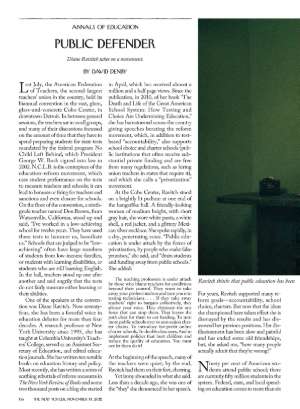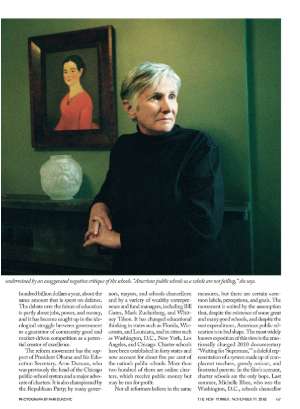Ravitch: “The high school graduation rate for people ages 18-24 is 90%, the highest in our history.”
Annals of Education
by David Denby The New Yorker November 19, 2012 | http://nyr.kr/TjNYvs

ABSTRACT: ANNALS OF EDUCATION about Diane Ravitch, who has emerged as one of the leading opponents of the education-reform movement. Now seventy-four, Ravitch has been a forceful voice in education debates for more than four decades. A research professor at New York University since 1995, she has taught at Columbia University’s Teachers’ College, served as an Assistant Secretary of Education, and edited education journals. She has written ten notable books on education history and policy. Most recently, she has written a series of scathing rebuttals of reform measures in The New York Review of Books and some two thousand posts on a blog she started in April, which has received almost a million and a half page views. Since the publication, in 2010, of her book “The Death and Life of the Great American School System: How Testing and Choice Are Undermining Education,” she has barnstormed across the country giving speeches berating the reform movement, which, in addition to test-based “accountability,” also supports school choice and charter schools (public institutions that often receive substantial private funding and are free from many regulations, such as hiring union teachers in states that require it), and which she calls a “privatization” movement. The reform movement has the support of President Obama and his Education Secretary, Arne Duncan; it is also championed by the Republican Party; by many governors, mayors, and schools chancellors; and by a variety of wealthy entrepreneurs and fund managers, including Bill Gates, Mark Zuckerberg, and Whitney Tilson. It has changed educational thinking in states such as Florida, Wisconsin, and Louisiana, and in cities such as Washington, D.C., New York, Los Angeles, and Chicago. Ravitch argues that the reform movement is driven by an exaggerated negative critique of the schools, and that it is mistakenly imposing a free-market ethos of competition on an institution that, if it is to function well, requires coöperation, sharing, and mentoring. Before she opposed the reform movement, Ravitch advocated for it: for years, she supported many reform goals, but now that the ideas she championed have taken effect she is dismayed by the results and has disavowed her previous positions. Her disillusionment has been slow and painful and has ended some old friendships. Today, Karen Lewis, the president of the Chicago Teachers Union, describes Ravitch as “the intellectual leader—and the intellectual soul—of the resistance to reform.” Writer visits Ravitch at her Brooklyn home, and describes her career and evolving political sensibility.
David Denby, Annals of Education, “Public Defender,” The New Yorker, November 19, 2012, p. 6
Read more: http://www.newyorker.com/reporting/2012/11/19/121119fa_fact_denby#ixzz2DRh7ijft
●●smf: Unfortunately the article is hidden behind a paywall [$6,95] unless you are a NYer subscriber – and even then it’s hard to get in! But hey, that’s what public libraries are for!
Revitch’s response to The New Yorker Profile
by Diane Ravitch in her blog | http://bit.ly/TsaTru
November 27, 2012 // In its issue of November 19, The New Yorker published a lengthy profile of my efforts to change national education policy: to halt the galloping privatization, the demonization of teachers and the misuse of testing to advance the two previously mentioned topics.
Let me begin by saying that I was immensely grateful that this distinguished and influential magazine gave attention to these important issues. As everyone who follows this blog knows, it is very rare to see a critique of the ruinous bipartisan policies in print or on television.
I was also thrilled that David Denby wrote the article. He is not a player in the debates and was able to approach the issues with a fresh and unbiased perspective. By now, everyone in education has chosen sides.
I had other reasons to be grateful that Denby was on the case. He is well educated and cares genuinely about education (in one of his books, he describes a year he spent as an adult auditing Columbia’s famous “great books” classes). In addition, he spent a lot of time immersing himself in the subject. In addition to reading widely and interviewing many people on all sides of the issues, he accompanied me to four events from mid-April in Atlantic City to the end of July in Detroit and interviewed at length.
I have enormous respect for him as a writer and a thinker. Also, I enjoyed the time I spent with him. He is funny, insightful, and smart. As he picked my brain about education, I tried to pick his about film and books.
And I am grateful to him for two surprising reasons. My conversations with him encouraged me to start this blog and to write a book during the summer.
However, there were two inaccuracies in the article that I feel compelled to correct because they go to the heart of my argument against the current wave of destructive policies.
Both NCLB and Race to the Top are based on the spurious claim that our public schools as a whole are failing. I argue that this narrative is false. The article refers to my criticism of this “exaggerated negative critique” but then cites statistics that are wrong.
According to the article, I allegedly said that “high school graduation rates are higher than ever” at 75.5%. That’s the four-year graduation rate, the number that Arne Duncan and Bill Gates use to claim that rates are flat and we have made no progress in 30 years.
But that is not the number I use. The graduation rate for people ages 18-24 is 90%. That includes August graduates, as well as those who earned their diploma in five or six years or got a GED.
So let me say that again: the high school graduation rate for people ages 18-24 is 90%, the highest in our history.
The same paragraph says, “She mentioned a slight increase, among all ethnic groups, in reading and math scores on national tests.” This was an especially galling inaccuracy, because the fact checker asked me about it and I said it was wrong. I sent the NAEP data and a copy of my AFT speech in Detroit to the fact checker to demonstrate what I did say: test scores are not slightly increased. They are at their highest point in history for all ethnic groups. The scores of black and Hispanic students have increased in reading steadily and significantly over the past 20 years. The scores of black and Hispanic students in mathematics have increased dramatically over the past 20 years.
Yet despite my protest that I did not say “slight increase,” and my documentation with both the NAEP data and my speech, the erroneous statement was left in the article.
One may argue that my interpretation is wrong, but one cannot argue that these statements can be attributed to me.
The New Yorker decided not to print my correction, which is why I am writing it here.




1 comment:
How to get a
best ged book test.
Post a Comment